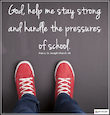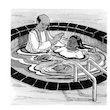Building Faith Community in the High School
About this article
This article features wisdom from Saint Mary's Press faith community workshop participants on how to overcome two identified obstacles to building faith community in schools: (1) differences that seem to divide people and (2) a lack of orientation to prayer and spirituality. Ideas for fostering an appreciation for diversity range from forming a "Community of the School" committee, being consciously inclusive, and recruiting a diverse faculty, to immersion experiences and mediation teams. Ideas to foster a prayerful spirit are also discussed and include prayer groups, retreats, student-led prayer, and student ministry councils. This article offers excellent ideas from practitioners!
In a workshop entitled "The Catholic High School as Faith Community," religion teachers, campus ministers, and school administrators discussed, among many things, the obstacles they face in trying to build faith community in their school. One obstacle they addressed was "lack of widespread commitment to the Catholic identity and mission of the school." Participants in the workshop offered one another their own "one-minute wisdom" on how to foster commitment to the school's Catholic identity.
This article looks at the wisdom and advice offered by some of the workshop participants on two other obstacles to building faith community:
- differences that seem to divide people--for example, racial, cultural, religious, economic, academic, gender, and individual differences
- lack of orientation to prayer and spirituality, especially shared prayer
DEALING WITH DIVERSITY
Community of the School Committee
In our school, which is very diverse, we decided to try to build community among the different groups by creating a Community of the School committee. We gathered together students representing the racial, ethnic, and religious diversity in our school and wrote a mission statement. We came up with a calendar of events to celebrate our need for community and our various gifts and talents.
The committee planned and carried out the following projects: (1) a Big Sister/Little Sister program, matching seniors with ninth graders; (2) an all-school field event day, with ten stations set up; (3) dialogue sessions among classes; (4) a talent show; (5) a Christmas assembly that focused on twenty-six different cultural backgrounds; (6) Respect Day, collaborating with student council, campus ministry, and Social Justice Club; and (7) programs on protecting yourself from violent or manipulative relationships. Peg Lindwall, Mount Saint Joseph Academy, Brighton, MA
Consciously Inclusive
Our school makes a conscious effort to be inclusive. In a city where most Catholic high schools (there are twenty-five) are single sex, single race, middle-class, and college prep, we provide an option. We have academic programs for honors, college prep, basic, and learning-disabled students. Peer tutoring is offered; honor students tutor those who are having academic trouble.
We are coed and economically and racially mixed, with scholarships and work-study available. We try to stress the importance of inclusive language, using inclusive examples in teaching. Students from different religions are encouraged to talk about their faith. We have programs for black history and women's history, and we address issues of sexual harassment among students. Michealla Neal, De La Salle High School, New Orleans, LA
Immersion Experiences
Since our school is in the rural Midwest, I try to help students be in touch with diversity through immersion experiences, whether one day or a week long. These are solid opportunities for students to leave behind most stereotypes and molds while expanding cultural, personal, and life horizons.
I have exposed students to the Appalachian, Mississippi black, El Paso (Hispanic), inner-city (Chicago, Columbus, and Minneapolis), and political (Washington, D.C.) cultures. The experiences include miniworkshops; reflection on communication skills, gender roles, and interactions; shared responsibilities; and prayer. The days of these immersion experiences revolve around prayer times. Rodney Bluml, Newman Catholic High School, Mason City, IA
A "Dweebs" Game
[To foster compassion in the students for those who are different or on the margins], we do a game in freshman religion class where I choose one or two students to be "dweebs" temporarily, with their permission. Other students shun them for several days; I treat them as inferior in class. A day or two after the game has ended, we process in class how everyone felt. Theresa Mulligan, Bishop Fenwick High School, Middletown, OH
Conscious Recruitment
Schools with a diverse student population need to make conscious efforts to recruit a diverse faculty to encourage the students. We also need to find better ways to utilize people in the community who reflect the cultures the students come from.
Our admissions and financial aid policies should allow students of varying cultures and economic backgrounds to attend. We need to avoid an "elitist" tag. That means taking in percentages of students of varying academic abilities, and providing support services for them using federal, state, and city programs. Dave Boris, Cleveland Central Catholic High School, Cleveland, OH
An International Club
Having a student body with great cultural diversity, we started an International Club--no more Spanish Club, Italian Club, Black/Hispanic Club, and so on. This way everyone is welcome and we celebrate everyone's special week or day all year. In May we celebrate Mary Around the World with our May crowning. We pray in many languages (last year, thirty-two different ones). The girls dress in their native costumes. After the prayer service, we continue into lunchtime with native and folk dancing and displays of international goods. It really celebrates our differences. Anne Madruga, Presentation High School, San Jose, CA
Mediation Teams
For dealing with conflict between students, we have developed mediation teams--groups of students who are trained to listen to the persons in a conflict and facilitate dialogue. Usually the conflict involves an offense (like fighting) for which the students could be suspended. In that situation, they are given the choice to either be suspended or go through mediation. Confidentiality by all parties involved is a top priority. The mediation team students run the process, with one faculty member staying in the room as an observer or to refocus the discussion if necessary.
On our student retreats, someone who has been through mediation gives a "mediation talk," a faith witness about how the mediation process changed his or her view or heart. Peg Lindwall, Mount Saint Joseph Academy, Brighton, MA
FOSTERING A PRAYERFUL SPIRIT ACROSS THE SCHOOL
Prayer Groups
We have started several small voluntary prayer groups. Friday mornings we have a fifteen-minute faculty and staff prayer service before school. It's based on morning praise--psalms, readings, meditations, and intercessions--safe and predictable. Wednesday mornings we have a half-hour Bible study before school with students and faculty. We use a guidebook, have sharing, and end with a brief time of prayer.
A weekly moms' group meets for forty-five minutes during the school day to pray for specific needs of the school. It's patterned after Moms in Touch, an evangelical international movement.
We also offer an elective class on spirituality for juniors and seniors, focusing specifically on issues of faith and of integrating faith into our life. Connie Zimney, Benilde-Saint Margaret's School, Saint Louis Park, MN
Student-Led Prayer
In our religion classes, we begin class with prayer. I assign my students the responsibility of leading prayer each class, whether it be a prayer they make up or one they read, a poem they've written, or a recorded song. I ask them to introduce their prayer as an extension of their faith and spirituality. Angela Gentile, Marist School, Atlanta, GA
Creative Planning with Students
Students are often very interested in getting involved with developing prayer experiences. Let them be a part of the creative brainstorming for planning a service, and let them go through the whole decision-making process with you. Be very open and attentive to their gifts and talents so they can be utilized to their fullest. Guide them, encourage them, support them, respect them, trust them, and empower them. They will often pleasantly surprise you. Roxane Molinari, Cathedral High School, Saint Cloud, MN
Morning Prayers
We ask the religion teachers for all four grades to have each student write a prayer. The teachers then select some of them to be read over the PA system for our morning prayers. We try to do this for Advent, Lent, and Easter time. At other times, students pick the prayers that are read over the PA system each morning. Br. Pat McNulty, Roselle Catholic High School, Roselle, NJ
A School Ministry Council
We are initiating a School Ministry Council. The membership is a cross section of the school--students, alumni, parents, parish priests, faculty, staff, and administrators. They will form an advisory council to help develop and evaluate workshops, retreats, and service projects. Fr. George Majoros, Archbishop Wood High School, Warminster, PA
KARIOS RETREATS
A number of participants in the "Faith Community" workshop spoke of their experiences with Kairos ("the Lord's time") retreats, which are voluntary for seniors. They see these retreats as key to fostering a prayerful spirit and a sense of faith community in their schools. The effect of the retreats on the participating seniors is powerful, and younger students benefit by anticipating going on one of these retreats in their senior year. The importance of spirituality in the life of the school is affirmed by the importance given to Kairos retreats.
These three-and-a-half-day retreats are led by seniors or alumni who have been on a Kairos retreat before. A campus minister or teacher is the adult director. In addition, faculty and staff from across the school are part of the process as helpers to the student leaders--the broader the participation beyond the "religion experts," the better.
A Kairos retreat, according to its supporters, has to be experienced in order to be understood. One cannot simply read a book on it or buy a "kit." The best way for a school to consider introducing it for their seniors is to send a delegation of students and faculty to another school's Kairos retreat to experience it firsthand. This retreat movement began in Jesuit schools but has spread to many diocesan and religious-order high schools.
Acknowledgments
(Copyright © 2000 by Saint Mary's Press. Permission is granted for the free use of this article for classroom or campus ministry purposes; however, it may not be republished in any form without the written permission of Saint Mary's Press. For more resources to support your ministry, call 800-533-8095, or visit our Web site at www.smp.org.)
Published October 1, 1996.






